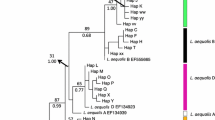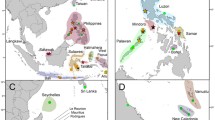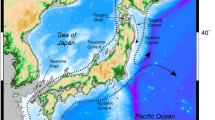Abstract
Although numerous coastal marine species show intra-specific lineage splitting and population divergence times that date to the period of glacial cycles during the Pleistocene epoch, reported instances of recent speciation in the coastal marine environment are relatively rare. Marine organisms with brood-protection and other reproductive modes with limited dispersal potential have been suggested to experience more frequent speciation and extinction events than related species with higher dispersal rates, but few studies have actually estimated divergence times of sister species in these organisms. Here, two mitochondrial gene regions (cytochrome oxidase subunit I, putative control region and upstream tRNAs) and a nuclear gene region (Elongation factor 1α subunit intron 4) provide evidence of recent (0.5–1.2 Mya) cladogenetic events in four pairs of putative sister taxa in a predominantly North Pacific brooding subgenus of sea stars (Leptasterias subgenus Hexasterias). Calibration is obtained from a trans-arctic migration in a related clade of sea stars (Leptasterias subgenera Hexasterias and Nesasterias) that is timed to the opening of the Bering Strait at 3.5 ± 0.25 Mya, and uncertainty in the calibration point is accommodated with a normally-distributed Bayesian prior probability. Similar estimates of population splitting times for two of the pairs of putative sister taxa were obtained by a multilocus coalescent analysis. Estimates of mitochondrial mutation rates (0.01/My) were approximately 50% of the values calibrated for sister species pairs in tropical sea stars and sea urchins.




Similar content being viewed by others
References
Addison JA, Hart MW (2005) Colonization, dispersal, and hybridization influence phylogeography of North Atlantic sea urchins (Strongylocentrotus droebachiensis). Evolution 59:532–543
Avise JC (2000) Phylogeography: the history and formation of species. Harvard University Press, Cambridge
Avise JC, Walker D, Johns GC (1998) Speciation durations and Pleistocene effects on vertebrate phylogeography. Proc R Soc Lond B 265:1707-1712
Bernatchez L, Wilson CC (1998) Comparative phylogeography of Nearctic and Palearctic fishes. Mol Ecol 7:431-452
Bickford D, Lohman DJ, Sodhi NS, Ng PKL, Meier R, Winker K, Ingram KK, Das I (2006) Cryptic species as a window on diversity and conservation. Trends Ecol Evol 22:148–155
Crame JA (1997) An evolutionary framework for the polar regions. J Biogeogr 24:1–9
Dawson MN (2001) Phylogeography in coastal marine animals: a solution from California? J Biogeogr 28:723–736
Dawson MN, Hamner WM (2008) A biophysical perspective on dispersal and the geography of evolution in marine and terrestrial systems. J R Soc Interface 5:135–150
Drummond AJ, Ho SYW, Phillips MJ, Rambaut A (2006) Relaxed phylogenetics and dating with confidence. PLoS Biol 4:e88. doi:10.1371/journal.pbio.0040088
Fisher WK (1930) Asteroidea of the North Pacific and adjacent waters, Pt. 3: forcipulata (Concluded). Bull US Nat Mus 76:1–356, plates 1–93
Flowers JM, Foltz DW (2001) Reconciling molecular systematics and traditional taxonomy in a species-rich clade of sea stars (Leptasterias subgenus Hexasterias). Mar Biol 139:475-483
Foltz DW (2007) An ancient repeat sequence in the ATP synthase β subunit gene of forcipulate sea stars. J Mol Evol 65:564–573
Foltz DW, Flowers JM (2007) Small-scale morphological differentiation in three brooding sea star species with limited dispersal. In: Proceedings of the 12th international Echinoderm conference, Balkema, Rotterdam (in review)
Foltz DW, Hrincevich AW, Rocha-Olivares A (2004) Apparent selection intensity for the cytochrome oxidase subunit I gene varies with mode of reproduction in echinoderms. Genetica 122:115-125
Foltz DW, Stickle WB, Campagnaro EL, Himel AE (1996a) Mitochondrial DNA polymorphisms reveal additional genetic heterogeneity within the Leptasterias hexactis (Echinodermata: Asteroidea) species complex. Mar Biol 125:569-578
Foltz DW, Breaux JP, Campagnaro EL, Herke SW, Himel AE, Hrincevich AW, Tamplin JW, Stickle WB (1996b) Limited morphological differences between genetically identified cryptic species within the Leptasterias species complex (Echinodermata: Asteroidea). Can J Zool 74:1275-1283
Foltz DW, Bolton MT, Kelley SP, Kelley BD, Nguyen AT (2007a) Combined mitochondrial and nuclear sequences support the monophyly of forcipulatacean sea stars. Mol Phyl Evol 43:627-634
Foltz DW, Nguyen AT, Nguyen I, Kiger JR (2007b) Primers for the amplification of nuclear introns in sea stars of the family Asteriidae. Mol Ecol Notes 7:874–876
Gladenkov AY, Olenik AE, Marincovich L Jr, Barinov KB (2002) A refined age for the earliest opening of the Bering Strait. Palaeogeo Palaeoclimat Palaeoecol 183:321–328
Hart MW, Byrne M, Smith MJ (1997) Molecular phylogenetic analysis of life-history evolution in asterinid starfish. Evolution 51:1848–1861
Held C (2001) No evidence for slow-down of molecular substitution rates at subzero temperatures in Antarctic serolid isopods (Crustacea, Isopoda, Serolidae). Polar Biol 24:497–501
Hewitt GM (2004) Genetic consequences of climatic oscillations in the Quaternary. Philos Trans R Soc Lond B 359:183–195
Hickerson MJ, Cunningham CW (2005) Contrasting quaternary histories in an ecologically divergent sister pair of low-dispersing intertidal fish (Xiphister) revealed by multilocus DNA analysis. Evolution 59:344–360
Ho SYW (2007) Calibrating molecular estimates of substitution rates and divergence times in birds. J Avian Biol 38:409–414
Hrincevich AW, Foltz DW (1996) Mitochondrial DNA sequence variation in a sea star (Leptasterias spp.) species complex. Mol Phyl Evol 6:408-415
Hrincevich AW, Rocha-Olivares A, Foltz DW (2000) Phylogenetic analysis of molecular lineages in a species-rich subgenus of sea stars (Leptasterias subgenus Hexasterias). Am Zool 40:365-374
Hudson RR, Turelli M (2003) Stochasticity overrules the “three-times rule”: Genetic drift, genetic draft, and coalescence times for nuclear loci versus mitochondrial DNA. Evolution 57:182–190
Huelsenbeck JP, Crandall KA (1997) Phylogeny estimation and hypothesis testing using maximum likelihood. Annu Rev Ecol Syst 28:437-466
Jacobs DK, Haney TA, Louie KD (2004) Genes, diversity, and geologic process on the Pacific coast. Annu Rev Earth Planet Sci 32:601-652
Knott KE, Wray GA (2000) Controversy and consensus in asteroid systematics: new insights to ordinal and familial relationships. Am Zool 40:382-392
Knowles LL (2000) Tests of Pleistocene speciation in montane grasshoppers (genus Melanoplus) from the sky islands of western North America. Evolution 54:1337–1348
Lessios HA (1998) The first stage of speciation as seen in organisms separated by the Isthmus of Panama. In: Howard DJ, Berlocher SH (eds) Endless forms: species and speciation, Oxford University Press, New York, pp 186–201
Lessios HA, Kessing BD, Pearse JS (2001) Population structure and speciation in tropical seas: Global phylogeography of the sea urchin Diadema. Evolution 55:955–975
Lessios HA, Kessing BD, Robertson DR, Paulay G (1999) Phylogeography of the pantropical sea urchin Eucidaris in relation to land barriers and ocean currents. Evolution 53:806–817
Lovette IJ (2005) Glacial cycles and the tempo of avian speciation. Trends Ecol Evol 20:57-59
McCartney MA, Keller G, Lessios HA (2000) Dispersal barriers in tropical oceans and speciation in Atlantic and eastern Pacific sea urchins of the genus Echinometra. Mol Ecol 9:1391–1400
Marincovich L, Gladenkov AY (1999) Evidence for an early opening of the Bering Strait. Nature 397:149–151
Marincovich L, Barinov KB, Olenik AE (2002) The Astarte (Bivalvia: Astartidae) that document the earliest opening of the Bering Strait. J Paleontol 76:239–245
Marko PB (2004) ‘What’s larvae got to do with it?’ Disparate patterns of post-glacial population structure in two benthic marine gastropods with identical dispersal potential. Mol Ecol 13:597-611
Marko PB, Palmer AR, Vermeij GJ (2003) Resurrection of Nucella ostrina (Gould, 1852), lectotype designation for N. emarginata (Deshayes, 1839), and molecular genetic evidence of Pleistocene speciation. Veliger 46:77-85
McEdward LR, Miner BG (2001) Larval and life-cycle patterns in echinoderms. Can J Zool 79:1125–1170
Pearse JS, Lockhart SJ (2004) Reproduction in cold water: paradigm changes in the 20th century and a role for cidaroid sea urchins. Deep Sea Res II 51:1533–1549
Ravelo AC, Andreasen DH, Lyle M, Olivarez-Lyle A, Wara MW (2004) Regional climate shifts caused by gradual global cooling in the Pliocene epoch. Nature 429:263–267
Ray N, Currat M, Excoffier L (2003) Intra-deme molecular diversity in spatially expanding populations. Mol Biol Evol 20:76-86
Rutschmann F (2006) Molecular dating of phylogenetic trees: a brief review of current methods that estimate divergence times. Divers Distribut 12:35–48
Smith AB (1994) Rooting molecular trees: problems and strategies. Biol J Linn Soc 51:279–292
Uthicke S, Purcell S, Blockmans B (2005) Natural hybridization does not dissolve species boundaries in commercially important sea cucumbers. Biol J Linn Soc 85:261–270
Vermeij GJ (1991) Anatomy of an invasion: the trans-Arctic interchange. Paleobiology 17:281–307
Wares JP, Cunningham CW (2001) Phylogeography and historical ecology of the North Atlantic intertidal. Evolution 55:2455-2469
Wares JP, Cunningham CW (2005) Diversification before the most recent glaciation in Balanus glandula. Biol Bull (Woods Hole) 208:60-68
Welch JJ, Bromham L (2005) Molecular dating when rates vary. Trends Ecol Evol 20:320–327
Acknowledgments
Drs. S.W. Herke, J. Xing, M. Konkel and M.A. Batzer provided technical advice concerning the PCR and cloning reactions. Dr. R. Van Syoc arranged the loan of tissue pieces from the California Academy of Sciences Collection. Drs. J.M. Flowers, A.W. Hrincevich, M. Katoh, J.S. Pearse, V. Pearse, S.K. Sarver and W.B. Stickle, Jr. collected some of the specimens. Drs. Hrincevich and Axayacatl Rocha provided some of the mitochondrial sequences. M. Heier, C. James and I. Nguyen assisted in the laboratory. Drs. J.M. Flowers, B. Carstens and C.C. Austin provided helpful discussion and comments. Funding was provided in part by NSF grant OPP-9707806 to D.W.F.
Author information
Authors and Affiliations
Corresponding author
Additional information
Communicated by T. Reusch.
Electronic supplementary material
Below is the link to the electronic supplementary material.
Rights and permissions
About this article
Cite this article
Foltz, D.W., Nguyen, A.T., Kiger, J.R. et al. Pleistocene speciation of sister taxa in a North Pacific clade of brooding sea stars (Leptasterias). Mar Biol 154, 593–602 (2008). https://doi.org/10.1007/s00227-008-0952-9
Received:
Accepted:
Published:
Issue Date:
DOI: https://doi.org/10.1007/s00227-008-0952-9




